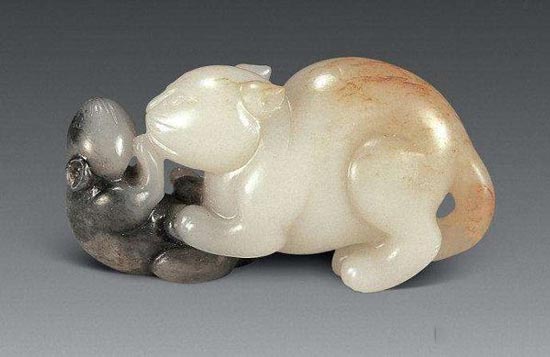The Ming and Qing jade carvings were the last peak of China's feudal era, and the source of jade materials was sufficient. Together with the Qianlong Emperor's love for jade and the social and economic development, the jade carvings of the Qing Dynasty developed unprecedentedly, especially during the Qianlong period. In general, during the Ming and Qing Dynasties, the Office of the Ministry of Internal Affairs, Suzhou, and Yangzhou had the most distinctive features: the Ministry of Internal Affairs created the jade for the royal family, and the craftsmanship was first-class, and it was still good at making ornaments, antiques, and accessories. Suzhou jade is elegant and engraved, and is good at making and making practical instruments. Yangzhou jade is vivid and good at carving of Yushanzi. The House of Internal Affairs is the institution that manages the banned rooms of the Imperial Palace in the Qing Dynasty. It is based on the Seventh Division and the Third House, and the Office of Creation is one of the agencies of the House of Internal Affairs. The Office is the agency responsible for the manufacture, repair and storage of the various items used by the empress and the court. In the Qing Dynasty, the palace was made directly by the founding office. The jade craftsmen of the founding office were mostly recruited from Suzhou and Yangzhou. The Qianlong jade is mainly made up of antiques. The antique jade articles of the Qing Palace Office have developed and changed the ancient jade shape and achieved high achievements. The ornaments and accessories work for excellence and meticulousness, no matter big or small. , or the work of the shape, surface, and pattern are very particular. The court jade is more about programmatic production. The processing of larger jade parts is first processed by selecting materials, paintings, and then by sawing, making blanks, ornamentation, polishing, etc. Antique jade is still worn, and some jade articles are also inscribed. At the time of processing, each person is responsible for a certain process, and the techniques such as inscription, yang, embossing, and enamel carving are fully exerted. Even the secondary parts such as the inner heel, the side wall or the bottom foot are meticulous, making the whole to the part perfectly harmonious. Such a fine work, a counter-yuan, Ming Yu as a ubiquitous rough style. Suzhou Saitama craft is very developed. In addition to Beijing, Suzhou has gathered a lot of jade carving craftsmen, especially in Suzhou, all the craftsmen are concentrated, and many masters emerge. Emperor Qianlong once praised: "The phase system is a sloppy section, and the lanes are dedicated to the hands of the people", "the jade craftsmen in the alleys are all, and the sunrise is endless." The jade articles in Suzhou are optimized with accessories and utilities, and the most famous one is Lu Zigang. He is a member of Mingjiajing and Wanli seventy-seven Taicang. "Taicang Fuzhi" has a record on this man-made jade: "Carving with a knife, é‚ é‚ ã€‚. Today's ç°ª ç°ª price, a price of fifty or sixty Kim. Zigang died, his skills are not passed down." The jade articles he made were mostly jade, ink pool, jade evil spirits and so on. Most of his works are in the "Zi Gang", "Zi Gang", "Zi Gang" and other models, good at all kinds of shapes, especially the son of Gang Pei is best known. His flat and inscriptions are both wonderful works, both in terms of pictures and numbers. The existing Zigang models have more jade articles, which are really mixed. The thin tireware made in Suzhou, the combination of gold and silver patterns, lettering, title, and the combination of poetry, calligraphy and painting all represent the level of jade technology in the Qing Dynasty. Yangzhou jade works featuring furnishings and mountain ornaments, and has many giant systems. Under the slogan of Emperor Qianlong, the annum that weighed more than 10,000 pounds could also be transported from Xinjiang to the mainland and between Beijing and Yangzhou. The most famous one is the "Dayu Water Control Map" Shanzi, which took more than ten years before and after, fully demonstrating the national financial resources and the ability of the jade. These large-scale mountain jade carvings develop in the form of scenes, and pursue the form of gods and tastes, landscape paintings, and exquisite workmanship, which have become the main symbols of the prosperity of the jade articles of the Qing Dynasty. From the contemporary white jade to the contemporary, the jade carving industry has developed in an all-round way. There are jade carving factories in many provinces, cities and regions in China, and the number of employees has reached more than 100,000. A number of masters of arts and crafts have emerged. Horse Riding Saddle Pads, Saddle Pads Equine Equipment, Equestrian Riding Saddle Pads Guangzhou Muxin Sporting Goods.Ltd. , https://www.muxinsports.com